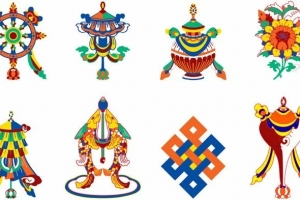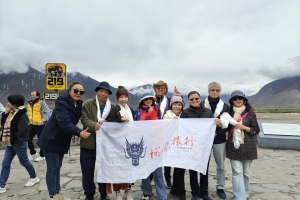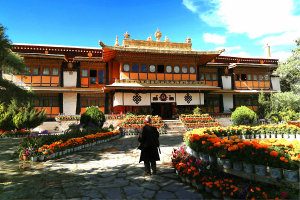When traveling through Tibet, Nepal, Bhutan, or Himalayan Buddhist regions, you will often hear, see, or feel the mantra “Om Mani Padme Hum” everywhere: inscribed on prayer wheels, carved onto mani stones, painted on walls, intoned by monks, whispered by pilgrims. This six-syllable Sanskrit phrase lies at the heart of Tibetan Buddhism, embodying the essence of compassion, purification, and awakening.
For international tourists curious about Tibetan spiritual culture, understanding Om Mani Padme Hum is like unlocking a doorway into the inner life of the land you are visiting. In this guide, you will learn its origins, meaning, symbolism, methods of practice, modern benefits, and how to respectfully engage with it during your travels.
The Origins and Age of Om Mani Padme Hum
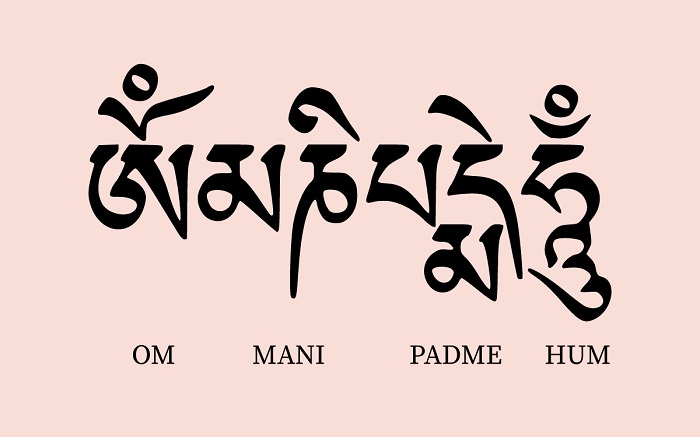
Origins in Mahayana Buddhism and Early Transmission
The mantra Om Mani Padme Hum has ancient roots in Mahayana Buddhism, and it is intimately tied to the Bodhisattva Avalokiteshvara (the Bodhisattva of Compassion). While the precise historical moment of its origin is shrouded by time, the mantra was widely transmitted by the 8th century across Tibet as Buddhism spread into the Himalayas.
Some traditions hold that the mantra was taught by Shakyamuni Buddha himself—or by enlightened disciples—and later adopted by Tibetan masters as a central devotional practice. Over the centuries, it became woven into Tibetan culture, art, ritual, and daily life.
The “Six True Words”
Because it consists of six syllables—Om, Mani, Padme, Hum—this mantra is often called the “Mantra of Six True Words.” Each syllable is symbolic and carries deep significance, representing distinct facets of the Buddhist path of transformation. Though the literal translation is difficult to pin down precisely, many practitioners view the mantra as a condensed distillation of Buddhist wisdom and compassion.
Symbolism and Meaning of Om Mani Padme Hum
Understanding each syllable can enrich one’s practice. Below is a common traditional interpretation:
Om
Om is often seen as the primordial syllable, encompassing the pure, universal sound of the cosmos. It points to the heart of Buddhahood, the awakened state prior to dualistic thinking.
Mani
Mani means “jewel” or “treasure” in Sanskrit. It often symbolizes the jewel of altruistic intention or compassion—a wish that all beings may be freed from suffering.
Padme
Padme means “lotus.” The lotus is a common Buddhist symbol: it grows from muddy water yet rises pure and beautiful, untouched by impurity. Padme represents the purity of wisdom that blooms even in the world’s confusion.
Hum
Hum expresses the indivisibility of method and wisdom—how compassionate action and clear realization are inseparable. It also indicates resolve and steadfastness in the path to enlightenment.
When combined, Om Mani Padme Hum is sometimes loosely paraphrased as:
“The jewel in the lotus”
or
“May the jewel (of compassion) dwell in the lotus (of wisdom).”
Yet, many teachers caution against rigid literal translation. The mantra is more experiential than lexical, inviting the practitioner into a living resonance of compassion, purification, and awakening rather than merely being a phrase to understand.
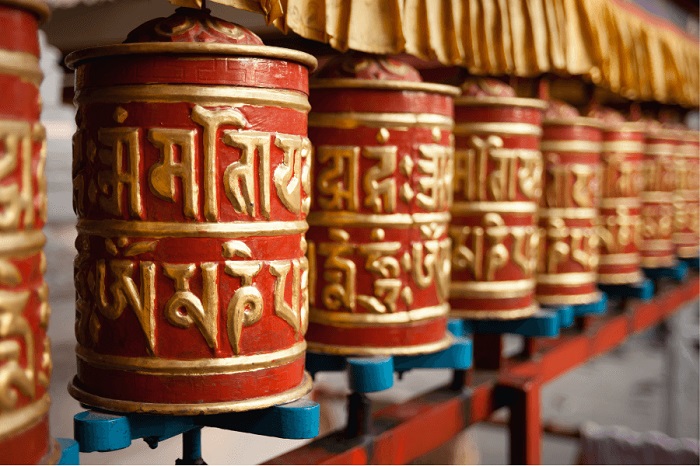
What Chanting “Om Mani Padme Hum” Does
Purification of Mind and Karma
One profound effect of repeating the mantra is purification—cleansing the mind of obscurations, negative habits, and karmic traces. As one recites, the impurities of body, speech, and mind are gradually transformed into clear light.
Calming and Centering the Mind
Chanting the mantra helps settle the restless mind. Whether recited aloud, softly, or mentally, the vibration and rhythm guide one into a meditative space. Anxiety, impulsiveness, or scattered thoughts can soften and yield to deeper stillness.
Cultivation of Compassion
Because the mantra is inseparably linked to Avalokiteshvara—the embodiment of boundless compassion—its practice naturally fosters empathy, loving-kindness, and care toward all beings. Over time, one’s heart becomes more open and more responsive to the suffering of others.
Supporting Spiritual Growth
When practiced with sincerity and continuity, the mantra can accelerate spiritual progress. It aligns one’s intentions and daily life with the qualities of wisdom and compassion, creating harmony between inner aspiration and outer action.
Psychological and Physical Benefits
Though the mantra is primarily spiritual, many practitioners experience clearer thinking, improved emotional balance, reduced stress, and a calming effect on the nervous system. The regularity of focused chanting can bring a sense of peace, stability, and well-being.
How Many Times to Chant It
There is no rigid prescription for how many times one must recite Om Mani Padme Hum each day. Some guidelines and traditions do exist:
- 108 times is a common recommendation, due to the significance of 108 in many Eastern traditions (108 beads on a mala, etc.).
- In dedicated retreat or mantra meditation sessions, practitioners may chant hundreds, thousands, or tens of thousands of times.
- Some Tibetan practitioners carry prayer wheels or mani stones so that each turn or each prostration becomes part of their chanting practice.
Ultimately, consistency and sincerity matter more than sheer quantity. A modest daily recitation done with sincerity is often more beneficial than a large count done mechanically.
When and How to Chant Om Mani Padme Hum
Best Times to Chant
While Om Mani Padme Hum may be chanted at any time, many practitioners favor chanting:
- In the morning, to set a compassionate tone for the day.
- In the evening, as reflection, purification, and closure.
- During meditation sessions, helping focus and deepen concentration.
- During stress or difficulty, to calm the mind and invoke compassion.
Methods of Chanting
- Vocal Chanting
Saying the mantra aloud allows you to feel the vibration, hear the sound, and use breath and articulation. - Soft Whispering or Low Voice
Some prefer to chant softly so as not to disturb others yet still feel subtle vibration. - Mental Chanting / Silent Repetition
In this form, the mantra is recited quietly in the mind. This is often recommended in advanced practice to avoid distraction and deepen internal resonance. - With a Mala or Prayer Beads
Using a mala (typically 108 beads) helps keep count, maintain discipline, and focus attention. Each bead represents one recitation. - Walking or Prostration Chanting
Along pilgrimage paths or temple circumambulations, practitioners may chant at every step or turn of a prayer wheel. Some combine chanting with prostrations or walking meditation.
Attitude and Intention
Perhaps more important than method or count is intention. Chanting should be done with respect, devotion, sincerity, and a genuine wish to help oneself and others. Mechanical or casual recitation without heart may diminish its transformative power.
Can Anyone Chant It? Are There Restrictions?
One of the powerful aspects of Om Mani Padme Hum is its accessibility. Generally:
- Anyone open to cultivating compassion and wisdom may chant it, regardless of background or religious status.
- There is no exclusivity or initiation requirement in most contexts.
- However, it is important to approach it respectfully, rather than as a novelty or tourist souvenir.
That said, if someone recites the mantra as mockery, disrespect, or with improper intent, it may be considered spiritually counterproductive. In Tibetan Buddhism, the potency of the mantra is linked to the purity of one’s mind and intention.
What Happens When You Chant Daily?
Committing to daily chanting of Om Mani Padme Hum can bring gradual and lasting changes:
Improved Mental Clarity and Focus
Regular repetition helps train the mind to concentrate. Attention becomes more stable, distractions fewer.
Emotional Balance
Compassion and introspection nourish emotional maturity. Negative states like anger, jealousy, or anxiety soften over time.
Spiritual Awakening
Daily practice aligns one’s inner trajectory with the path of awakening. Over time, insights may emerge more readily, and one’s life becomes gradually more infused with wisdom and compassion.
Purification and Karma Transformation
Persistent chanting gradually purifies the subtle negative tendencies accumulated over lifetimes. As mental obscurations diminish, spiritual light becomes clearer.
Physical Relaxation
When mind and breath calm, the body relaxes. Many practitioners report reduced tension, enhanced rest, and a deeper sense of well-being.
Silent Chanting: Power Without Voice
Yes—the mantra can be chanted silently in the mind, and many advanced practitioners prefer this method. Benefits of silent chanting include:
- Deep inner focus without distraction by external sound
- Subtle resonance in mental channels and energy centers
- Flexibility to chant in public or quiet spaces discreetly
- A contemplative environment in which the mantra merges with awareness
Although vocal chanting has its own merits, silent repetition can be equally profound when undertaken with clarity, attention, and devotion.
Common Misunderstandings and Myths of Om Mani Padme Hum
“I Must Understand the Exact Literal Meaning”
While interesting, trying to pin down a rigid literal translation—or reducing it to a mere phrase—misses the point. Om Mani Padme Hum is meant to be felt, intoned, and internalized, not dissected like a dictionary entry.
“I Need a Special Initiation or Guru to Chant”
Although in certain advanced Buddhist paths initiation may be meaningful, for Om Mani Padme Hum most traditions accept sincere chanting by anyone without formal initiation.
“The More I Chant, the Better Automatically”
While frequent, heartfelt chanting is beneficial, what matters more is sincerity, mindfulness, and integration—not performing until exhaustion without awareness.
“Chanting Alone Guarantees Enlightenment”
Chanting is a powerful aid, but it is not a shortcut. It is complementary to ethical conduct, meditation, study, and compassionate action.
Experiencing Om Mani Padme Hum on Your Travels
As a traveler in Tibet, Nepal, Bhutan, or Himalayan Buddhist regions, you will witness Om Mani Padme Hum in many forms:
- Prayer Wheels spun by pilgrims along temple courtyards
- Mani Stones and Walls, engraved with the mantra in Tibetan script
- Prayer Flags, inscribed and fluttering in wind, carrying blessings
- Temple Rituals, where monks chant in groups, creating a resonant soundscape
- Local Homes and Businesses, often displaying the mantra in auspicious places
Observing these expressions of devotion offers insight into how integrated the mantra is in local life. Tourists are welcome to spin wheels, recite the mantra quietly, or even participate respectfully in local ceremonies.
Be mindful: always ask permission, follow local custom, and maintain respectful silence or demeanor in sacred spaces.
Integrating the Mantra into Daily Life
You don’t need to be on pilgrimage to sustain your practice. Even at home, in a hotel, or in your travel journey:
- Start and end your day with 10–20 silent or vocal recitations
- Use the mantra as a centering anchor during stressful moments
- Incorporate it into your meditation session
- Visualize the mantra in your heart, radiating compassion to all beings
- Use short breaks (walking, waiting) to chant mentally
Over time, the mantra becomes a subtle companion—a spiritual thread weaving through the tapestry of your life.
Why International Travelers Should Care
- Cultural immersion: Understanding the mantra helps you appreciate Tibetan Buddhist culture on a deeper level.
- Spiritual souvenir: The mantra is a living experience you can carry with you—not just a photo.
- Inner refuge: During long journeys or jet lag, chanting offers a calming spiritual anchor.
- Connection with locals: Learning basic Tibetan chants or customs fosters mutual respect and connection.
- Personal transformation: A travel mantra practice can deepen insight and compassion, turning a vacation into a spiritual journey.
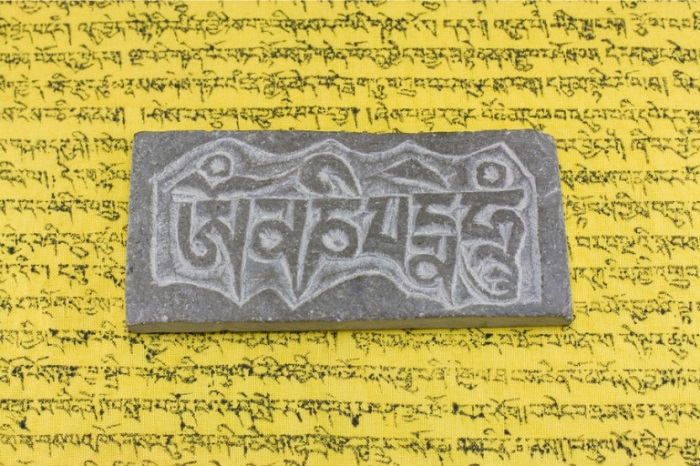
Common Questions Tourists Ask
Can I chant it even if I’m not Buddhist?
Yes — it is open to all sincere practitioners. The mantra transcends religious boundaries; it is a practice of compassion and awareness that many people adopt regardless of spiritual label.
Is there a “correct accent” or pronunciation?
There is variation in Tibetan, Sanskrit, and local pronunciations. The sincerity and meaning behind the chant matter more than perfect accent. When traveling, try to learn the local phonetics to show respect.
Can I buy a prayer wheel or mani stone as a souvenir?
Yes, but purchase ethically from respected monasteries or shops. Avoid buying mass-produced or culturally insensitive items. If possible, combine it with a donation.
Should I spin every prayer wheel I see?
Tourists may spin prayer wheels, but always in the correct direction (usually clockwise), and with reverence. Observe local people first and follow their example.
What if I chant incorrectly?
There is no “wrong” if your intention is sincere. Simply continue with respect and gradually learn from local teachers or texts.
Embracing the Spirit of Om Mani Padme Hum on Your Tibet Journey
For tourists crossing the Tibetan plateau, visiting monasteries in Lhasa, walking pilgrim circuits around Mount Kailash, or trekking among Bhutan’s Dzongs, the presence of Om Mani Padme Hum is nearly everywhere. It invites you, as a visitor, not merely to witness but to engage—quietly, respectfully, and with curiosity.
Carry a mala, recite softly in mountain dawns, spin a prayer wheel at sunset, pause before a mani wall to chant in your inner space. Let the mantra become a companion on your journey—a living bridge between your mind and the sacred land before you.
By weaving the chant into your pilgrimage or travels, you deepen your experience; what might begin as a spiritual souvenir becomes a living tradition you carry home. The vibrations of Om Mani Padme Hum resonate not only across Himalayan passes, but within your own heart and life.
Note: For travelers seeking guided tours, spiritual immersion, or cultural exploration in Tibet and Himalayan Buddhist regions, Journey2Tibet offers curated itineraries, expert local guides, and meaningful experiences that help you connect more deeply with the sacred mantra traditions and Buddhist heritage across the Tibetan world.






